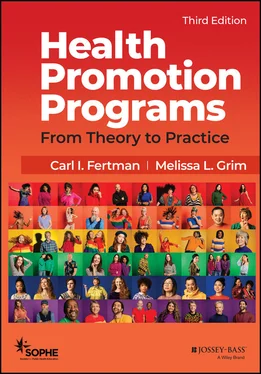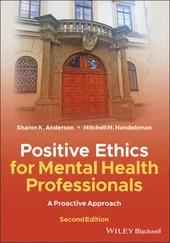(SOPHE) Society for Public Health Education - Health Promotion Programs
Здесь есть возможность читать онлайн «(SOPHE) Society for Public Health Education - Health Promotion Programs» — ознакомительный отрывок электронной книги совершенно бесплатно, а после прочтения отрывка купить полную версию. В некоторых случаях можно слушать аудио, скачать через торрент в формате fb2 и присутствует краткое содержание. Жанр: unrecognised, на английском языке. Описание произведения, (предисловие) а так же отзывы посетителей доступны на портале библиотеки ЛибКат.
- Название:Health Promotion Programs
- Автор:
- Жанр:
- Год:неизвестен
- ISBN:нет данных
- Рейтинг книги:5 / 5. Голосов: 1
-
Избранное:Добавить в избранное
- Отзывы:
-
Ваша оценка:
- 100
- 1
- 2
- 3
- 4
- 5
Health Promotion Programs: краткое содержание, описание и аннотация
Предлагаем к чтению аннотацию, описание, краткое содержание или предисловие (зависит от того, что написал сам автор книги «Health Promotion Programs»). Если вы не нашли необходимую информацию о книге — напишите в комментариях, мы постараемся отыскать её.
Health Promotion Programs: From Theory to Practice
Health Promotion Programs: From Theory to Practice
Health Promotion Programs — читать онлайн ознакомительный отрывок
Ниже представлен текст книги, разбитый по страницам. Система сохранения места последней прочитанной страницы, позволяет с удобством читать онлайн бесплатно книгу «Health Promotion Programs», без необходимости каждый раз заново искать на чём Вы остановились. Поставьте закладку, и сможете в любой момент перейти на страницу, на которой закончили чтение.
Интервал:
Закладка:
Geographic Location
In the United States, differences in one’s geographic location (i.e. neighborhood, town, community) are linked to variations in illness and death. In comparison with White children, Hispanic and African American children are more likely to live in communities near toxic waste sites. African Americans are more likely to live in communities that are less likely to have parks, green spaces, walking or biking trails, swimming pools, beaches, or commercial outlets for physical activity such as physical fitness facilities, sports clubs, dance facilities, and golf courses (Padilla et al., 2016). Further, those living in very poor neighborhoods often lack supermarkets with fresh produce.
Access to Healthcare
The United States is the richest country on the world and its healthcare system is the most complex of all; it is also the most expensive in relation to the percentage of the GDP and the expenditures per capita. Health expenditures in the United States duplicate the average expenses reported by other high-income countries. However, mortality related to healthcare accessand quality is significantly higher in comparison to other high-income countries and some low and middle-income countries. The U.S. healthcare system is complex, with combined private and public funding, many different insurance structures, and mostly private service delivery (the latter excepting for the VA, the chronically underfunded Indian Health Service, and the insurance for the active military). It is also the most inequitable among similar countries (Geyman, 2018; Jones & Kantarjian, 2019).
In the United States, there is an unreasonable relationship between the cost of the medical services and the patients’ income, ability to pay, and health insurance situation. For instance, in 2019 there were about 30 million uninsured people. This, despite the advances made by ACA, that substantially reduced the uninsured by over 20 million. Insurance data confirm inequities: while 6.3 percent of the uninsured are non-Hispanic Whites, 10.5 percent are African Americans, 16 percent Hispanic/Latinos, 7.6 percent Asians, and about 20 percent Native Americans (Himmelstein et al., 2018).
Access barriers to healthcare are multiple and different across the nation, they go from the impossibility to obtain healthcare among the uninsured to the scarcity of health professionals (particularly in primary care) and the reduced cultural humility that the systems shows in many places to minorities and people living in poverty (Nervi, 2016). Access barriers have been proven to have a direct effect in hospitalization rates, morbidity, and mortality.
Digital Divide
Despite the widespread use of the Internet and social media platforms, a persistent digital divide exists. Studies have concluded that Internet access and use vary by individual characteristics and geographic location. There is also evidence of disparities in online health-seeking behavior (Din et al., 2019; Walker et al., 2020).
High-speed Internet is essential for obtaining health information, and healthcare services, which contribute to people’s well-being and human rights. From this perspective, the digital divide is a matter of social injustice. While there are many reasons why some individuals use the Internet and others do not, availability and affordability are two main factors contributing to the digital divide. Related to those is computer and new technologies literacy. These factors must be explored and addressed in the context of perpetuated societal and educational inequities, and keeping in mind that those groups most disenfranchised by the digital divide are the same groups suffering the most from socio-economic and political marginalization. In the United States, while nine in ten American adults use the Internet, adoption gaps remain based on factors such as age, income, education, and community type. Rural Americans are more likely than those who live in urban or suburban settings to never use the Internet. Racial minorities, older adults, rural residents, and those with lower levels of education and income are less likely to have broadband service at home. Internet non-adoption is linked to a number of demographic variables, including age, educational attainment, household income, and community type. Minority serving schools, where over 50 percent of the student population belongs to minority racial or ethnic groups, have smaller ratios of high-speed, Internet-accessible computer for every student. Similarly, in high-minority and/or high-poverty communities, student access to this resource is limited (Anderson et al., 2019).
Actions to Advance Health Equity and Social Justice
What can health promotion and health education practitioners do to properly address health inequities? Since health inequities are the result of policies and practices that create unequal societies, we must propose interventions that assure everyone’s opportunity to attain their highest level of health. This can be achieved by addressing the social determinants of health and equity. In other words, we must pay attention to the roots causes of inequity. There is sufficient evidence on the role of macro social, political, and economic factors on the pathogenesis of disease, not only in individuals but also in entire populations. From this perspective, sensitive governmental actions can reduce health inequity by ensuring basic services such as education and healthcare. Government can also address social and health inequity by protecting and promoting human rights such as affordable housing, equal employment opportunities for all, gender equity, and minimum wages that allow workers to keep up with cost of living (Blas et al., 2008).
Name and Address Racism
Acknowledge racism as a system of structured inequity and not an individual character flaw. Name racism as a determining force in the distribution of the social determinants of health and equity. Identify the structures, policies, practices, norms, and values in which racism may be operating. Among the variety of causes of racial and ethnic disparities in health, racism is the one factor that needs some explanation. Race is a social construct, not a biological reality. Unlike age, neither race nor ethnicity have fixed, objective referents—that is, they have no scientific markers for anyone to verify but are terms that are self-adopted or imposed (EqualHealth, n.d.). In general in the United States, one is assigned to a race based on the color of one’s skin, which does not begin to capture the genetic and cultural differences among those residing in the United States who are assigned to the racial category of Black (Jones, 2001).
While we often characterize our American society as a great melting pot and while the relationships between individuals assigned to different racial categories have improved dramatically, race still governs the distribution of risks and opportunities in our society to a great degree. Jones (2001) describes three types of racism that affect health outcomes: institutionalized racism, personally mediated racism, and internalized racism. Institutionalized racism is described as differential access to goods, services, resources, and opportunities by race. For example, the majority of minority children attend high-poverty, under-resourced schools, while the percentage of White children attending this type of school is much lower. Personally mediated racism is discrimination in which the majority racial group treats members of a minority group as inferior and views the minorities’ abilities, motives, and intents through a lens of prejudice based on race. This type of racism is what most individuals think of when they hear the term racism . It manifests as lack of respect, suspicion, devaluation, scapegoating, and dehumanizing. Internalized racism is acceptance by members of the stigmatized race of negative messages about their own abilities and intrinsic worth. It manifests as self-devaluation, helplessness, and hopelessness, potentially leading to risky behaviors that can endanger a person’s health.
Читать дальшеИнтервал:
Закладка:
Похожие книги на «Health Promotion Programs»
Представляем Вашему вниманию похожие книги на «Health Promotion Programs» списком для выбора. Мы отобрали схожую по названию и смыслу литературу в надежде предоставить читателям больше вариантов отыскать новые, интересные, ещё непрочитанные произведения.
Обсуждение, отзывы о книге «Health Promotion Programs» и просто собственные мнения читателей. Оставьте ваши комментарии, напишите, что Вы думаете о произведении, его смысле или главных героях. Укажите что конкретно понравилось, а что нет, и почему Вы так считаете.












